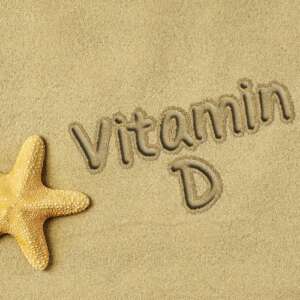 This week we have an informative article on Vitamin D from naturopathic clinician Katherine Matthews.
This week we have an informative article on Vitamin D from naturopathic clinician Katherine Matthews.
Katherine is a leading naturopathic clinician, nutritionist and medical herbalist based in Auckland and Tauranga. She works as her clients’ advocate and educator, combining current scientific evidence with traditional naturopathic knowledge to increase wellness.
Katherine works with a range of health concerns and specifically is passionate about women’s health, mental health, anxiety, depression and fasting. She has recently returned from the United States where she was working at a medically supervised water fasting facility. Using her knowledge of fasting, Katherine supports her clients to choose and implement a fasting protocol that is right for them.
She believes in a model of disease prevention and health promotion, and that when people are healthy they are able to contribute their unique talents to the world with more resilience, compassion and vitality. Our health and vitality is required in the transformation of our systems and the unswerving structures within it.
Katherine believes a big part of wellness is the people around us and how we communicate to each other. As part of this she works in schools and runs groups teaching youth peer mediation and how to create connections in conflict to build and repair relationships. She is passionate about increasing the wellness of our communities so that we can all thrive and live our vibrant lives together.
You can find out more about Katherine’s treatment programs via her website katherinematthews.co.nz.
Vitamin D – Why You May Not Be Getting Enough and How To Prevent Deficiency:
Vitamin D is commonly known as the sunshine vitamin. This amazing vitamin is synthesised from sunlight on our skin. In New Zealand with long summers at our baches, the many days we spend outdoors, and lying on the beach, you wouldn’t think we were susceptible to vitamin D deficiency. Commonly I hear from my clients, “I only need to expose myself for 10- 20 minutes a day to get my vitamin D, right?” Unfortunately it’s just not that simple, as studies estimate that almost half of the population in New Zealand have average vitamin D levels below 50 nmol/L classified as a mild deficiency, while 3-4% of people have levels lower than 17.5 nmol/L, classified as a severe deficiency. However, there are many ways in which you can prevent becoming deficient. Read on to get an overview of this important nutrient so that you can prevent deficiency and make sure your vitamin D levels are optimal for yourself and your family’s health.
What does Vitamin D do?
Vitamin D is a fat soluble vitamin that is stored in the liver and fatty tissues of the body. It is most commonly known to be important for calcium balance and bone health, however more evidence is emerging that this vitamin supports many other physiological processes in the body. Vitamin D also plays a crucial role in immune function, blood pressure regulation and cell growth. Poor vitamin D status is implicated in conditions such as rickets (weak or misshapen bones), osteoporosis, multiple sclerosis and cancer. Recent evidence suggests it is also associated with poor outcomes in Covid 19.
How is Vitamin D Made?
Unlike other vitamins, Vitamin D is classified as a steroidal hormone. The synthesis of vitamin D begins in the skin with exposure to ultraviolet B light, and continues in the liver and kidneys. Vitamin D obtained through the diet or supplementation is absorbed in the gut and then undergoes the same process in the liver and kidneys as sun derived vitamin D3. The enzymes involved in Vitamin D metabolism rely on magnesium for vitamin D activation and function. Therefore it’s important to maintain magnesium intake.
Risk Factors for Deficiency
Currently many of us are not being exposed to sufficient UVB sunlight to make enough vitamin D. The amount of sunlight you can be exposed to in New Zealand is determined by factors such as latitude, season, clothing, occupation, mobility, ozone layer, age and occupation. Most of us are affected by one or more of these factors.
Seasons and Latitude
The further south of the equator we live, the more prone we are to a potential vitamin D deficiency due to UVB radiation being reduced. Additionally the amount of vitamin D we can make from season to season can vary widely. One study performed in Christchurch showed that people made 1200 IU/day of vitamin D midsummer, compared to 60 IU/day in the midwinter. They also found that overall 88% of people had suboptimal vitamin D levels most of the time, indicating that summer exposure was not enough to increase levels for the winter months.
Ozone Hole
Additionally in New Zealand we have the hole in the ozone layer to contend with, and seeking the healthy balance of sun exposure versus skin damage can be difficult to find. Most of us find ourselves applying copious amounts of sunscreen to protect our skin (like myself) which protects us from sunburn and skin damage, but makes us vulnerable to vitamin D deficiency. There will be more detail on sensible sun exposure later on in the article.
Melanin Levels in the Skin
Dark skin pigmentation is another risk factor for deficiency. Maori people have lower vitamin D levels than European communities, and Pacifica people lower still. This is due to the higher amounts of melanin in the skin that acts as a natural sunscreen.
Age
Studies show that people in the early stages and the later stages of life, have higher risk for vitamin D deficiency. Older age has a profound effect on the skin’s ability to produce vitamin D. A person in their 70s produces 25% of the vitamin D compared to someone in their 20s. Population surveys from Australia and New Zealand have shown that 40-57% of newborns are deficient in vitamin D. Therefore if you are pregnant, monitoring your vitamin D levels
and correcting for insufficiency is an important step to preventing deficiency in your newborn.
Indoor Lifestyles
For many of us our jobs are inside and we no longer need to leave the house as often as we once did. Being able to order everything to our door has its advantages. However, it now means we need to intentionally schedule outdoor time into our days, and in our busy lives this quickly becomes low on our list of priorities.
Testing
Most of us are affected by one or more of the risk factors associated with vitamin D deficiency above. So how can you find out what your level of vitamin D is? You can self request a test through Labtests New Zealand. This test is not subsidised in New Zealand and costs about $70. In the clinic I recommend my clients get a test initially. Then it is possible to make a calculated plan on how much to supplement and for what length of time. However if you really don’t want to get a blood test most people can supplement vitamin D safely.
Optimal Level
Below is the New Zealand lab test reference range for vitamin D.
The target range is wide, which leads to the question:
WHAT IS THE LEVEL OF VITAMIN D THAT SUPPORTS OPTIMAL HEALTH AND VITALITY?
Controversy exists around the optimal level with many experts stating that the dietary recommendations are too low to maintain optimal health. The most widely characterised criteria for vitamin D adequacy is based on studies that show bone fracture prevention and preservation of bone mineral density. From these studies concentrations should exceed
75nmol/L. This fails to take into account optimal levels for other important physiological roles, such as immune function. Recent studies show that vitamin D levels influence risk for metabolic syndrome, cardiovascular diseases, autoimmune disorders, and cancer. When multiple health areas are taken into account the most optimal range is between 90-100
nmol/L.
How do I increase my vitamin D if my test results are low?
From Food
Very few foods contain Vitamin D3 (cholecalciferol). Fatty fish (such as tuna, mackerel, and tuna) and fish oils are among the best sources. Small amounts are found in beef liver, cheese and egg yolks. But even a healthy diet won’t contain enough vitamin D3 rich foods to reach a blood level that is optimal. Therefore, I recommend a vitamin D supplement.
Vitamin D Supplementation
If your test results come back and show a deficiency (below 50nmol/L in lab test range and/or below 85nmol/L naturopathically) there is the option of supplementation to increase your levels. Although you may be able to increase your levels through a regular sun exposure regime, due to the many factors listed above and the high risk our sun in NewZealand poses to our skin’s health, I recommend supplementing.
Prescription
You can speak to your doctor about your risk factors for vitamin D deficiency. They can write you a script for the recommended vitamin D supplement, cholecalciferol (fully funded). This form of vitamin D is also known as vitamin D3 and has shown to be the most highly absorbed form.
Prescription vitamin D3: You begin with a loading dose of two 1.25mg (50,000 IU) tablets taken immediately, then one tablet monthly for two consecutive months. This supplementation regime can change depending on the severity of the deficiency. Following this I recommend my clients get a follow up test to see if their level of vitamin D has risen to
an optimal level.
Over the Counter Supplementation
Levels of supplementation will depend on your test result, your age and risk factors. I have provided some general guidelines below but I do recommend talking to your health care practitioner before starting a supplement regime.
RDAS:
Here’s how to dose for supporting optimal vitamin D levels, by age:
0-12 months: 400 IU daily
1 to 13 years: 600 IU daily
14 to 18 years: 1000 IU daily
Adults: 1000-2000 IU daily
General Adult: To maintain optimal serum concentrations of vitamin D, an intake for all adults of ≥1000-2000 IU (25 mcg) vitamin D3 daily is recommended. It’s recommended to take the capsule with food to enhance absorption. Vitamin D3 supplements are quite affordable, usually around $15-$18 for 270 tablets.
Serum levels below 50 nmol/L:
If you go and get a serum blood test and your results show you are below 50nmol/L (sub optimal) you may require higher doses of vitamin D. Generally around 4,000 IU per day for eight to twelve weeks in order to correct this deficiency. Follow up screening is recommended at around three months to ensure that serum vitamin D levels are increasing. Again, I recommend speaking to your health practitioner so that they can support you with the right dosage for you.
Pregnancy and Lactation
In pregnancy and lactation the requirements of vitamin D may be higher. Poor maternal vitamin D status has been associated with poor pregnancy outcomes. One study highlighted low levels of vitamin D in 87% of New Zealand pregnant women. 1400 IU- 4000 IU daily depending on baseline values is recommended and more in breast feeding. Please talk to your midwife before starting a higher dose supplement regime.
Sensible Sun Exposure in New Zealand
Just a quick note on sun exposure in New Zealand. If it is safe for you to do so, sensible sun exposure is recommended daily to support vitamin D levels. Between September and April: A daily walk or some other form of outdoor activity before 10 and after 4pm. Sun protection is recommended between 10am and 4pm. Between May and August: Going outside for a walk around the middle of the day is recommended. Even having your hands and face exposed will support you to make some vitamin D. If the exposure to the sunlight is hard for you to do or poses a greater risk for you due to health reasons, you may require a vitamin D supplement all year around.
Summary
Go to your nearest lab test centre and self request a baseline vitamin D test. This is so that you know your levels and can make an informed decision of how you want to work at making your levels optimal.
Speak to your naturopath about ways to prevent vitamin D deficiency and also about your test results, to see how much you may need to supplement.
Get outside time daily! Getting some time in the sun daily so that your skin can absorb sunlight and make vitamin D is recommended. Follow guidelines on what time of day is safe and enjoy the fresh air and relaxation benefits while you do!
References:
Bpac, NZ. Vitamin D Supplementation. Retrieved from https://bpac.org.nz/bpj/2011/june/vitamin-d.aspx.
Ministry of Health. Nutrition: Vitamin D. Available from: www.moh.govt.nz/moh.nsf/indexmh/nutrition-vitamin-d (Accessed Mar, 2011).
Mason, K., Templeton, R., & Weerasekera, D. (2012). Vitamin D status of New Zealand adults: Findings from the 2008/09 New Zealand adult nutrition survey. Ministry of Health.
Daneshkhah, A., Agrawal, V., Eshein, A., Subramanian, H., Roy, H. K., & Backman, V. (2020). The possible role of vitamin D in suppressing cytokine storm and associated mortality in COVID-19 patients. MedRxiv.
Farraye, F. A., Nimitphong, H., Stucchi, A., Dendrinos, K., Boulanger, A. B., Vijjeswarapu, A., … & Holick, M. F. (2011). Use of a novel vitamin D bioavailability test demonstrates that vitamin D absorption is decreased in patients with quiescent Crohns disease. Inflammatory bowel diseases, 17(10), 2116-2121.
Uwitonze, Anne Marie, and Mohammed S. Razzaque. Role of Magnesium in Vitamin D Activation and Function The Journal of the American Osteopathic Association 118, no. 3 (March 2018): 181. https://doi.org/10.7556/jaoa.2018.037.
RUDE, R. K., ADAMS, J. S., RYZEN, E., ENDRES, D. B., NIIMI, H., HORST, R. L., … & SINGER, F. R. (1985). Low serum concentrations of 1, 25-dihydroxyvitamin D in human magnesium deficiency. The Journal of Clinical Endocrinology & Metabolism, 61(5), 933-940.
Livesey, J., Elder, P., Ellis, M. J., McKenzie, R., Liley, B., & Florkowski, C. (2007). Seasonal variation in vitamin D levels in the Canterbury, New Zealand population in relation to available UV radiation. The New Zealand Medical Journal (Online), 120(1262).
Bpac, NZ. Navigating the Great Debate. Retrieved from https://bpac.org.nz/bpj/2011/june/vitamin-d.aspx.
MacLaughlin, J., & Holick, M. F. (1985). Aging decreases the capacity of human skin to produce vitamin D3. The Journal of clinical investigation, 76(4), 1536-1538.
Paxton GA et.al Australian and New Zealand Bone and Mineral Society; Osteoporosis Australia. Vitamin D and health in pregnancy, infants, children and adolescents in Australia and New Zealand: a position statement. Med J Aust. 2013 Feb 18;198(3):142-3.
Holick, M. F., Binkley, N. C., Bischoff-Ferrari, H. A., Gordon, C. M., Hanley, D. A., Heaney, R. P., … & Weaver, C. M. (2011). Evaluation, treatment, and prevention of vitamin D deficiency: an Endocrine Society clinical practice guideline. The Journal of clinical endocrinology & metabolism, 96(7), 1911-1930.
Veugelers, P. J., & Ekwaru, J. P. (2014). A statistical error in the estimation of the recommended dietary allowance for vitamin D. Nutrients, 6(10), 4472-4475.
Vieth, R. (2006). What is the optimal vitamin D status for health?. Progress in biophysics and molecular biology, 92(1), 26-32.
Makariou, S., Liberopoulos, E. N., Elisaf, M., & Challa, A. (2011). Novel roles of vitamin D in disease: what is new in 2011?. European journal of internal medicine, 22(4), 355-362.
Bischoff-Ferrari, H. A., Giovannucci, E., Willett, W. C., Dietrich, T., & Dawson-Hughes, B. (2006). Estimation of optimal serum concentrations of 25-hydroxyvitamin D for multiple health outcomes. The American journal of clinical nutrition, 84(1), 18-28.
National Institute of Health, 2021. Vitamin D: Fact sheet for health professionals. Retrieved from https://ods.od.nih.gov/factsheets/VitaminD-HealthProfessional/.
Tripkovic, L., Lambert, H., Hart, K., Smith, C. P., Bucca, G., Penson, S., & Lanham-New, S. (2012). Comparison of vitamin D2 and vitamin D3 supplementation in raising serum 25- hydroxyvitamin D status: a systematic review and meta-analysis. The American journal of clinical nutrition, 95(6), 1357-1364.
Ministry of Health. Nutrition: Vitamin D. Available from: www.moh.govt.nz/moh.nsf/indexmh/nutrition-vitamin-d (Accessed Mar, 2011).
National Institute of Health, 2021. Vitamin D: Fact sheet for health professionals. Retrieved
from https://ods.od.nih.gov/factsheets/VitaminD-HealthProfessional/.
Bischoff-Ferrari, H. A., Giovannucci, E., Willett, W. C., Dietrich, T., & Dawson-Hughes, B. (2006). Estimation of optimal serum concentrations of 25-hydroxyvitamin D for multiple health outcomes. The American journal of clinical nutrition, 84(1), 18-28.
Nowson, C. A., & Mason, R. S. (2013). Vitamin D and health in adults in Australia and New Zealand. The Medical journal of Australia, 199(6), 394.
Gernand, A. D., Simhan, H. N., Caritis, S., & Bodnar, L. M. (2014). Maternal vitamin D status and small-for-gestational-age offspring in women at high risk for preeclampsia. Obstetrics and gynecology, 123(1), 40.
Eagleton, C., & Judkins, A. (2006). Vitamin D deficiency in pregnant New Zealand women. The New Zealand Medical Journal (Online), 119(1241).
Dawodu, A., & Akinbi, H. (2013). Vitamin D nutrition in pregnancy: current opinion. International journal of women’s health, 5, 333.
Ministry of Health. Vitamin D. Retrieved from https://www.health.govt.nz/your-health/healthy-living/food-activity-and-sleep/healthy-eating/vitamin-d.






About The Author: Katie Brooks
More posts by Katie Brooks